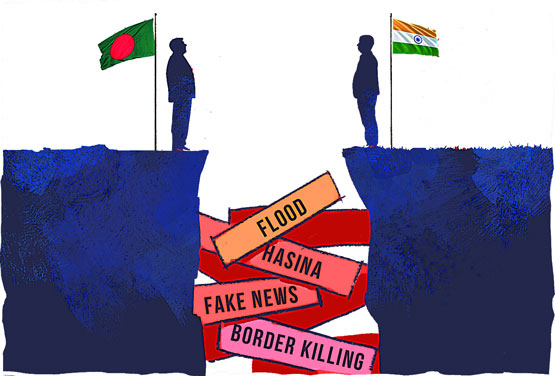A fresh trade salvo has rattled relations with Bangladesh as India’s Directorate General of Foreign Trade (DGFT) issued a notification on June 27, effective immediately, banning the import of nine key Bangladeshi products through all land border points. Only maritime imports via Nhava Sheva (formerly Novosheva) seaport in Mumbai are permitted. This marks the third round of trade restrictions imposed by New Delhi over the past three months, escalating tensions and threatening the Bangladesh export landscape.
Restriction Details: Nine Affected Items: The products now banned via land routes include: Raw jute, raw jute rolls. Jute yarn, including waste and flax yarn. These constitute a substantial segment of Bangladeshi exports to India, particularly in the jute and textile sectors.
Economic Impact: Export Revenue at Stake: According to National Board of Revenue (NBR) data, Bangladesh exported these nine items to 88 countries in FY 2023-24, earning $660 million (Tk 7,283 crore).
India, second only to Turkey as an importer, received about $150 million worth of these products-23% of the total export value of these goods. With land-route bans affecting 100% of these trade lines, the economic fallout is severe.
Overall, Bangladesh’s exports to India in FY 2023-24 totaled $1.59 billion, of which a staggering $650 million-roughly 40%-is now disrupted. The earlier May 17 ban on RMG, processed food, plastics, furniture, and more impacted $500 million in exports. This latest action adds another $150 million hit-bringing the cumulative total to $650 million.
Targeted Exporters: 117 Firms at Risk: NBR identifies 117 active land-route exporters of the affected items. Leading examples:Popular Jute Exchange (Narayanganj): $11.6 million in Bangladesh-origin jute exports to India last year, amounting to 50% of its total foreign trade.
Janata Jute Mills (Narsingdi, Akij Bashir Group): $13 million in jute exports to India, about 13% of its total exports.Many smaller players in jute yarn and fabric manufacturing stand on the brink due to the loss of land-route access and the limited capacity of the sea route.
Sea Route: A Rope Too Thin: Bangladeshi exporters may attempt to reroute shipments via Nhava Sheva, but only 1% of these nine goods are currently exported by sea. The rest flow through land due to convenience, shorter transit time, and lower cost. Redirection would not only raise logistics costs significantly-long routes, multiple customs clearances, and inland transport-but also increase delivery times, hurting competitiveness and profit margins.
Political Undercurrents and Diplomatic Fallout” This ban comes in a charged atmosphere. Analysts see a connection to:Reciprocal sanctions: Bangladesh’s April reversal on Indian yarn imports and the halting of Kolkata airport transshipment privileges triggered earlier Indian restrictions.
Political strain: Bangladesh interim Chief Adviser Muhammed Yunus’s remarks on India’s northeastern geography aggravated diplomatic tensions.
Protectionist pressure: India’s move is framed as a defense of its domestic jute industry, citing concerns over “dumping, subsidies, mislabelling, and import-through-third-countries”. Indian sources stress the need to control Bangladeshi imports via seaport regulation for transparency and traceability.
Bangladesh Response: BJSA Speaks Out: Tapas Pramanik, President of the Bangladesh Jute Spinners Association (BJSA), told the correspondent:”Due to India’s decision taken for political reasons, our exports of raw jute, jute yarn, and related products will be hampered. We are convening a meeting on June 30 to assess impact, then engaging government to find a way forward.”Pramanik stressed the impracticality of relying on the sea route via Mumbai-pointing to distance, costs, and time-as insufficient substitutes for the convenience of overland routes.
Business Voices: Alarm and Uncertainty: Selected exporter responses underscore the distress:One exporter noted that redistributing supply chains through sea ports increases costs by 30-40%, causing Indian buyers to find alternatives in Pakistan, Nepal, or even domestic suppliers.
Logistic providers warned of a collapse in land freight demand, leading to layoffs and licensing cancellations.Industry bodies like BGMEA, BCI, and BJSA have petitioned the governments of Bangladesh and India to rescind the ban or allow phased sea-route alternatives.
Economic Fallout: Wide-Ranging Consequences: Revenue Losses: Bangladesh forfeits $150 million in exports-about Tk 1,125 crore lost annually.Additional export curbs from May 17 add $500 million in potential losses.
SME Collapse: Smaller exporters lack the volume or capital to shift to costlier sea logistics.Trade Deficit Pressure: Bangladesh already imports far more from India, with trade imbalances thus widened.Logistics Fallout: Land shipping companies face collapse unless pivoting quickly.Employment Threat: Disrupted supply chains risk higher unemployment in borderland transport, warehousing, and manufacturing.
Diplomatic Strategies: What Needs to Happen: Economic Diplomacy Push:Bangladesh needs to deploy Economic Counselors in Delhi and Mumbai to negotiate access through Kolkata and Nhava Sheva ports-parallel to recent negotiations with Indonesia and Vietnam.Engage SAFTA Mechanisms:Bangladesh must challenge the ban under SAFTA (South Asian Free Trade Area) for being discriminatory against Bangladeshi goods.
Reinforce Quality Assurance:Introduce joint inspection protocols and traceability tools to address Indian concerns over dumping and mislabeling.
Support Affected Exporters:Provide subsidies, export credit, or warehousing assistance for exporters transitioning to sea logistics while negotiations continue.
Diversify Markets:Diversify shipments via sea to EU, US, Middle East, and expand trade with African and Latin American countries to cushion the blow.Way Forward: Targeted Unity: The BJSA meeting on June 30 is expected to map out immediate next steps-impact analysis, alternative logistics plans, and public messaging strategy.
At a state level, Bangladesh’s Foreign Ministry and Commerce Ministry must engage Indian counterparts-and multilateral trade platforms-to ensure the ban doesn’t escalate and new markets are unlocked.
A Strategic Red Alert: The ban on jute and allied goods signals a worrying escalation in cross-border trade tensions. For Bangladesh’s jute-heavy regions and vulnerable SMEs, the reliance on land routes has been all but severed.But the disruption can be mitigated through swift adaptation, diplomatic engagement, and policy incentives. Rebuilding trade routes and partnerships-and challenging the ban through international frameworks-must now become the shared mandate of government, trade bodies, and exporters.Without decisive action, the ban could mark a turning point-reshaping not just jute trade, but the broader landscape of Bangladesh-India economic relations.Related news on India-Bangladesh trade tensions: India bans specific jute, textile items from Bangladesh: Imports permitted only through Nhava Sheva seaport - new trade restrictions explained.

